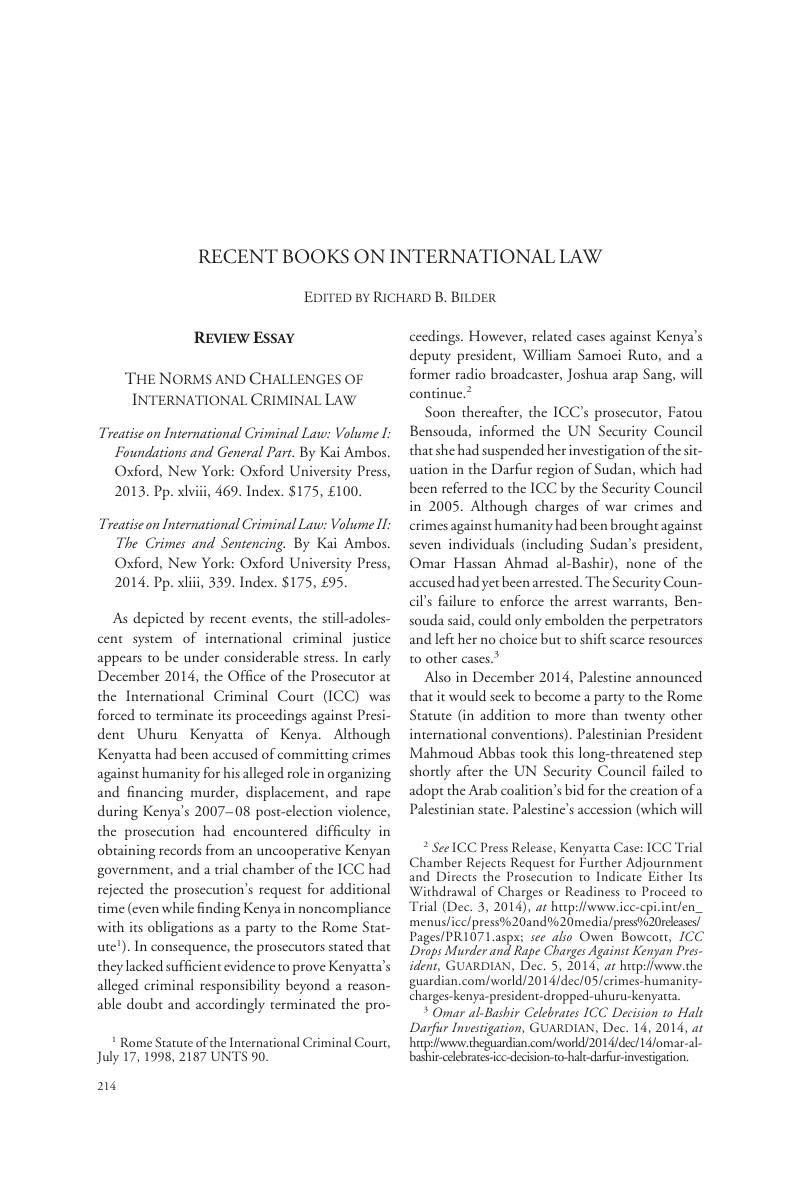Article contents
The Norms and Challenges of International Criminal Law, Treatise on International Criminal Law: Volume I: Foundations and General Part. By Kai Ambos. Oxford, New York: Oxford University Press, 2013. Pp. xlviii, 469. Index. $175, £100. - The Norms and Challenges of International Criminal LawTreatise on International Criminal Law: Volume II: The Crimes and Sentencing. By Kai Ambos. Oxford, New York: Oxford University Press, 2014. Pp. xliii, 339. Index. $175, £95.
Published online by Cambridge University Press: 20 January 2017
Abstract

- Type
- Recent Books on International Law
- Information
- Copyright
- Copyright © American Society of International Law 2015
References
1 Rome Statute of the International Criminal Court, July 17, 1998, 2187 UNTS 90.
2 See ICC Press Release, Kenyatta Case: ICC Trial Chamber Rejects Request for Further Adjournment and Directs the Prosecution to Indicate Either Its Withdrawal of Charges or Readiness to Proceed to Trial (Dec. 3, 2014), at http://www.icc-cpi.int/en_menus/icc/press%20and%20media/press%20releases/Pages/PR1071.aspx; see also Owen Bowcott, ICC Drops Murder and Rape Charges Against Kenyan President, Guardian, Dec. 5, 2014, at http://www.theguardian.com/world/2014/dec/05/crimes-humanity-charges-kenya-president-dropped-uhuru-kenyatta.
3 Omar al-Bashir Celebrates ICC Decision to Halt Darfur Investigation, Guardian, Dec. 14, 2014, at http://www.theguardian.com/world/2014/dec/14/omar-al-bashir-celebrates-icc-decision-to-halt-darfur-investigation.
4 Ruth Eglash & Carol Morello, Palestinian Leader Mahmoud Abbas Moves to Join International Criminal Court, Wash. Post, Dec. 31, 2014, at http://www.washingtonpost.com/world/israel-thanks-us-for-abstaining-on-security-council-resolution/2014/12/31/9b84cfa8-90d2-11e4-a412-4b735edc7175_story.html; Jodi Rudoren, Court Membership Wouldn’t Guarantee Palestinians a War Crimes Case, N.Y. Times, Jan. 2, 2015, at A6.
5 See, e.g., David Luban, Palestine and the ICC—Some Legal Questions, Just Security (Jan. 2, 2015), at http://justsecurity.org/18817/palestine-icc-legal-questions.
6 Mwangi S. Kimenyi, The International Criminal Court in Africa: A Failed Experiment?, Open Democracy (Nov. 11,2014), at https://www.opendemocracy.net/openglobalrights/mwangi-s-kimenyi/international-criminal-court-in-africa-failed-experiment.
7 Editorial, The International Criminal Court on Shaky Ground, Wash. Post, Dec. 31, 2014, at http://www.washingtonpost.com/opinions/the-international-criminal-court-on-shaky-ground/2014/12/28/8d11a3d6-815c-11e4-81fd-8c4814dfa9d7_story.html.
8 Cuba: America’s Most Wanted Woman Assata Shakur Will Not Be Extradited, Guardian, Dec. 23, 2014, at http://www.theguardian.com/world/2014/dec/23/cuba-assata-shakur-americas-most-wanted-woman-will-not-be-extradited.
9 European Convention for the Protection of Human Rights and Fundamental Freedoms, Art. 3, Nov. 4, 1950, ETS No. 5, 213 UNTS 222.
10 Trabelsi v. Belgium, App. No. 140/10 (Eur. Ct. H.R. Sept. 4, 2014) (rectified Oct. 14, 2014), at http://hudoc.echr.coe.int. See generally Caitlin Behles, European Court of Human Rights Rules on Terrorism Suspect’s Extradition to the US, ASIL Int’l L. IN BRIEF (Sept. 12, 2014), at http://www.asil.org/blogs/european-court-human-rights-rules-terrorism-suspect%E2%80%99s-extradition-us-september-4-2014.
11 See Trabelsi, supra note 10, para. 131.
12 Id., paras. 101, 121.
13 Id., para. 117.
14 Id., para. 127 (citation omitted).
15 Id., paras. 137–38 (citation omitted).
16 See id. (Yudkivska, J., concurring).
17 As the preface further states, “The treatise starts from the theoretical and doctrinal foundations of [international criminal law (ICL)] and takes into account, apart from the case law, the relevant English, French, German, Italian, Portuguese, and Spanish literature to distil general principles of law, essentially derived from the Anglo-American (‘common law’) and Romano-Germanic (‘civil law’) systems, thereby preparing a solid grounding incomparative law for the future ICL” (p. v).
18 See also Ambos, Kai, Punishment Without a Sovereign? The Ius Puniendi Issue of International Criminal Law: A first Contribution Towards a Consistent Theory of International Criminal Law, 33 Oxford J. Legal Stud. 293 (2013)CrossRefGoogle Scholar.
19 See Ambos, Kai, The Overall Function of International Criminal Law: Striking the Right Balance Between the Rechtsgut and the Harm Principles, 9 Crim. L. & Phil. 301 (Nov. 2013), at http://link.springer.com/article/10.1007%2Fs11572-013-9266-1Google Scholar.
20 Ambos defines JCE I as “the basic form, where the participants act on the basis of a ‘common design’ or ‘common enterprise’ and with a ‘common intention’” (p. 123). JCE II is the “systemic form, that is, the so-called ‘concentration camp cases’ where crimes are committed by members of military or administrative units, such as those running concentration or detention camps, on the basis of a common plan (‘common purpose’)” (id.). JCE III, is the “so-called extended [form], where one of the co-perpetrators actually engages in acts, going beyond the common plan, but his or her acts still constitute a foreseeable consequence of the realization of the plan” (pp. 123–24).
21 Rome Statute, supra note 1, Art. 25(3)(d).
22 Id., Art. 28(a).
23 Id., Art. 28(b).
24 Id., Art. 31(1)(c).
25 Prosecutor v. Erdemović, Case No. IT-96-22-A, Appeals Judgment (Int’l Crim. Trib. Former Yugo. Oct. 7, 1997).
26 Rome Statute, supra note 1, Art. 7(1)(g)–(h).
27 Signature strikes are attacks (for example, from the air) conducted against individuals who match predetermined characteristics or who engage in patterns of suspicious behavior considered in the context of the situation to be linked to militant or terrorist activity. The term is used to differentiate such attacks from those directed against identified individuals. According to Ambos, signature strikes include those “not directed at individually identified, alleged terrorists, included in a ‘kill list,’ but at groups of persons whose identities are unknown but who have a specific lifestyle or participate in certain activities which indicate their involvement in terrorist activities—’certain signatures, or defining characteristics associated with terrorist activity’” (p. 160).
28 The rule of distinction requires parties to the conflict to “distinguish” between combatants and civilians/noncombatants and between civilian objects and legitimate military objectives. See Protocol Additional to the Geneva Conventions of 12 August 1949, and Relating to the Protection of Victims of International Armed Conflicts, Art. 48, June 8, 1977, 1125 UNTS 3.
29 Agreement for the Prosecution and Punishment of the Major War Criminals of the European Axis, with Annexed Charter of the International Military Tribunal (London Charter), Aug. 8, 1945, 59 Stat. 1544, 82 UNTS 279.
30 Cf. Ambos, Kai & Timmermann, Anina, Terrorism and Customary International Law, in Research Handbook on International Law and Terrorism 20 (Saul, Ben ed., 2014)Google Scholar.
31 Cf. Ambos, Kai & Stegmiller, Ignaz, Prosecuting International Crimes at the International Criminal Court: Is There a Coherent and Comprehensive Prosecution Strategy?, 59 Crime L. & Soc. Change 415 (2013)CrossRefGoogle Scholar, available at http://link.springer.com/article/10.1007%2Fs10611-012-9407-9#page-1.
- 1
- Cited by




